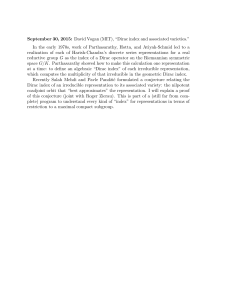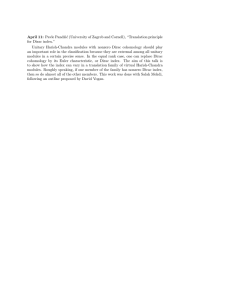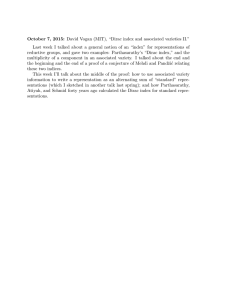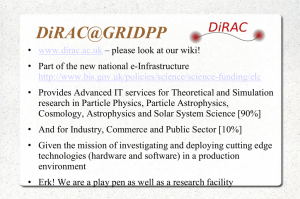The Dirac Equa-on, Zi2erbewegung and the Scalar Rela-vis-c Approxima-on
advertisement
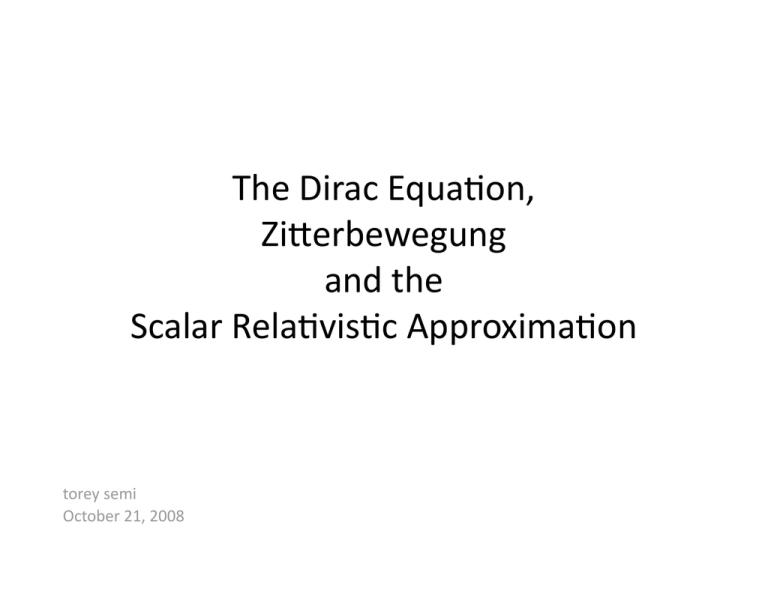
The Dirac Equa-on, Zi2erbewegung and the Scalar Rela-vis-c Approxima-on torey semi October 21, 2008 The Free‐par-cle Dirac Equa-on with and where ‘s Ξ the Pauli matrices; Ξ the 2x2 identity matrix; Ξ the rest energy of free particle (electron). Pauli matrices Whence the Dirac Equa-on? • Limita-ons of Schrodinger Equa-on • QED (quantum electrodynamics) – a descrip-on of the interac-on of light and ma2er – made possible by Dirac’s transforma-on theory – a rela-vis-c quantum field theory – highly accurate: to within 12 significant digits QED… • Predicts PROBABILITY of experimental outcome • Based on Lagrangian mechanics‐>path that minimizes ac-on func-onal • Field equa-ons – Star-ng point : Lagrangian density – For free Dirac field: where: adjoint spinor to Expansion gives: which has features similar to the Dirac equa-on. Equa-ons of Mo-on: we vary L with respect to which leads to and , the Schrodinger form of the Dirac equa-on. The Dirac equa-on provides: • A descrip-on of rela-vis-c systems • An equa-on whose solu-ons lead to rela-vis-c effects – Rela-vis-c mass increase – Electrosta-c & magne-c dipole energies – Spin‐orbit energy – Zi2erbewegung (Darwin term of expansion) In 1D, we can write: using the Dirac prescription to: • replace time-dependence with energy • work with an eigenvalue equation is a 4 x 4 matrix => is a four-spinor*; *a ‘spinor’ denotes a wavefunc-on with both linear (physical) momentum and spin (polariza-on) components. In expanded form, the equa-on becomes: • equa-on is in block‐matrix form • reduces to two (mathema-cally) equivalent two‐spinor equa-ons: and This result embodies the posi-ve and nega-ve energy solu-ons for which the Dirac equa-on is legendary.. Time‐Dependent Numerical Solu-ons Rever-ng to the -me‐dependent form of our coupled system of equa-ons, we can numerically solve for the wavefunc-ons: gives Numerical Solu-ons -me evolu-on of 1D Dirac equa-on for gaussian ini-al condi-on displays forward and backward -me evolu-ons (posi-ve and nega-ve energies) exhibits strange oscilla-ons and self‐interference effects plane wave solu-ons demonstrates phase differences between components Zi2erbewegung; a Rela-vis-c Consequence • look at equa-ons of mo-on for Dirac equa-on in Heisenberg representa-on: where Heisenberg picture…leads to: use canonical commuta-on rela-ons on : get expression for : Comparison with Classical Space Operator Classically: Quantum Mechanically: One‐par-cle Picture Zi2erbewegung Finer Points • Caused by interference of nega-ve and posi-ve energies • Heisenberg velocity operator not a constant of the mo-on • Strength propor-onal to ampl of neg energy waves of wavepacket • In presence of poten-al, represented by Darwin term Zi2erbewegung movies (Thaller) Dirac Equa-on: Connec-on to RDFT • Scalar Rela-vis-c Approxima-on – An approxima-on to the Dirac equa-on for a par-cle in a (central) poten-al (such as an electron near a nucleus) – Applicable to calcula-on of rela-vis-c effects in atoms and molecules – Approach is to discard spin‐orbit term Dirac Equa-on in Presence of Central Poten-al mass term Darwin term non‐rel Schrodinger Eqn ↓ ↙↘ ↑ spin‐orbit coupling term ↙ Scalar Rela-vis-c Approxima-on Spin‐orbit term on order of α4: Using: Scalar Rela-vis-c Approxima-on and we can write: or Scalar Rela-vis-c Approxima-on Set note that for ground state hydrogen, and we have: ↑ negligibly small term Connec-on to RDFT • Remaining poten-al terms incorporated into Kohn‐Sham equa-ons of DFT as effec-ve poten-al • Solu-ons sought.. References

